MAC's 1/72 Phönix D. & D.II
By Chris Banyai-Riepl
 |
History
Phönix got their start building Albatros B.1's, Brandenburg C.1's and D.1's before they got one of their own fighters accepted by Flars for large scale production. This was the Phonix D.1. A single seat fighter with a rather interesting wing cellule with inward sloping wing struts (known as the Sparmann wing), it was powered by the 200 hp Hiero engine and armed with two synchronized machine guns.
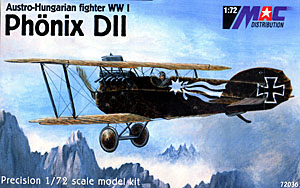 Robustly built, the D.1 possessed good flight characteristics and while not popular with every Flik, many came to prefer the type over other fighters of the day. However, in a response to pilots requests for "more speed!, more speed!" Phonix came up with the D.II.
Robustly built, the D.1 possessed good flight characteristics and while not popular with every Flik, many came to prefer the type over other fighters of the day. However, in a response to pilots requests for "more speed!, more speed!" Phonix came up with the D.II.
The D.II kept the same basic layout but lost weight where it could from the airframe. The cellule was lightened and vertical struts were used. In order to quicken the aircraft's response, shortened ailerons, a new tailplane and balanced elevators were added.
The Phönix D.I & D.II served in several Army units, and both the D.I and D.II found a place in the Navy defending the naval bases at Pola and Cattaro from attack by Italian bombers in 1918.
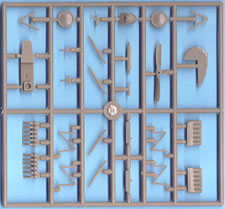 The Kits
The Kits
After looking at these latest kits from MAC it's amazing to see how far they've come since their Fokker E.IV. These kits are definite little gems. Both kits are molded in a tan plastic with crisp detailing and very little flash present. A bit of sanding will take care of that. Both kits share a common sprue of plastic parts and a PE set. The differences between the D.I and D.II kits are the decals and the fuselage/wing sprues. MAC did their homework here, providing different fuselages, wings, tailplanes, and even small details like the propellers and tail skids. Basically you need to decide which version you want and buy that specific kit. Ahh, who am I kidding, you're going to buy both!
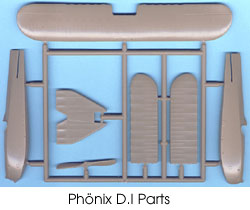 The interior is really decent out of the box, with a PE instrument panel, rudder pedals, seat belts and control stick. The seat is plastic, and all of this fits onto the floor, which, like earlier MAC releases, also includes the base for the engine. The engine is in two halves, with a single piece fitting on the top to make up the cylinder heads & exhaust stacks. Once the engine is together and painted up it should look pretty good, but some additional detailing could probably be added. Then again, once the fuselage is together not much more can be seen.
The interior is really decent out of the box, with a PE instrument panel, rudder pedals, seat belts and control stick. The seat is plastic, and all of this fits onto the floor, which, like earlier MAC releases, also includes the base for the engine. The engine is in two halves, with a single piece fitting on the top to make up the cylinder heads & exhaust stacks. Once the engine is together and painted up it should look pretty good, but some additional detailing could probably be added. Then again, once the fuselage is together not much more can be seen.
Once the fuselage is buttoned up the construction is very straightforward. There's not much to the plane, so all that's really left is to add the wings & tailplanes and paint it up. You'll 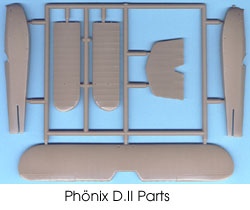 have to make sure you use the right radiator pieces for the upper wing, as both types are included in the shared sprue. One interesting feature of this kit is the use of PE for the tailplane struts. These were thin in real life so the photoetch parts should look pretty good here.
have to make sure you use the right radiator pieces for the upper wing, as both types are included in the shared sprue. One interesting feature of this kit is the use of PE for the tailplane struts. These were thin in real life so the photoetch parts should look pretty good here.
The decals provide several options, with two in the D.I kit and three in the D.II kit. Unfortunately the kit doesn't give any information about the pilots and only basic camouflage information in text. As such I had to dive into my references and see what I could find out about the planes. For the D.I, though, this turned out to be nothing, so I'll just describe what you get and hopefully someone else out there has more detailed information. The first scheme with a skull and crossbones positioned over the fuselage number '328.26' was flown by Feldwebel Johann Malz of Flik 14J. He had two victories (plus one unconfirmed). The second scheme also has something covering the fuselage number, this time a large white "16" covering up the "328.33". This one is from Flik 16 flown as photo-rec fighter by Oberleutnant Schultheiss and also Karl Urban.
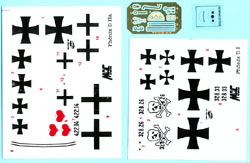 The D.II kit fills most of the decal sheet with aces, with Teichmann and Kasza being offered. Kasza's D.II has three white stripes around the rear fuselage, with a red heart right behind them on each side. A third heart is on the upper wing, centered. Teichmann's is also interesting, with a large red band around the rear fuselage behind the cockpit opening. On this is a white outline of a "T". This one has some interesting crosses, looking more like World War Two crosses than World War One. The third D.II is the one seen on the boxtop, from Flik 55J and featuring an interesting comet in white on the fuselage sides. This was flown by Oblt. Hans Leiner.
The D.II kit fills most of the decal sheet with aces, with Teichmann and Kasza being offered. Kasza's D.II has three white stripes around the rear fuselage, with a red heart right behind them on each side. A third heart is on the upper wing, centered. Teichmann's is also interesting, with a large red band around the rear fuselage behind the cockpit opening. On this is a white outline of a "T". This one has some interesting crosses, looking more like World War Two crosses than World War One. The third D.II is the one seen on the boxtop, from Flik 55J and featuring an interesting comet in white on the fuselage sides. This was flown by Oblt. Hans Leiner.
Conclusion
Easily the best 1/72 Phönix D.I and D.II kits out there, these definitely need to make their way into every WWI modeler's closet. The simple construction and interesting finish will make these a popular kit and these are both highly recommended.
References
The primary reference you'll want to get for these kits is the Datafile, but there's a few other useful books out there.
-
Datafile # 31: Phönix D.1 - D.II by Peter M. Grosz. Published by Albatros Publications, 1992, ISBN 0-98414-37-5
-
Austro-Hungarian Army Aircraft of World War One by Grosz, Haddow and Schiemer. Published by Flying Machines Press, 1993, ISBN 0-9637110-0-8
-
Air Aces of the Austro-Hungarian Empire 1914-1918 by Dr. Martin O'Connor. Published by Flying Machines Press, 1986, ISBN 0-9637110-1-6
